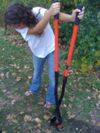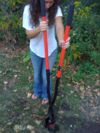Post hole digger redesign
From DDL Wiki
(→Usability Study) |
(→Usability Study) |
||
| Line 56: | Line 56: | ||
This particular test went much better than expected. Because the soil was quite loose at all depths, the subject was able to dig to a depth of 36" in just 4 minutes, completely blowing away her performance in the hard, grassy soil. Despite this overall success, the test did show some negative results. Once a depth of about 16" was reached, the user began having issues aiming. After this point, she repeatedly hit the top edge of the hole, caving it in, stroke after stroke. Figure 2.1.5 shows how sloppy the entry to the hole became as the user slowly destroyed it. Also, when the hole became roughly 24" deep, the handles of the digger began hitting the sides of the hole. This phenomenon is depicted in Figure 2.1.6. Throughout the entire experiment the subject struggled with actually removing the dirt from the hole. As the dirt continued to fall out of the shovel before removal, the user became visibly frustrated. | This particular test went much better than expected. Because the soil was quite loose at all depths, the subject was able to dig to a depth of 36" in just 4 minutes, completely blowing away her performance in the hard, grassy soil. Despite this overall success, the test did show some negative results. Once a depth of about 16" was reached, the user began having issues aiming. After this point, she repeatedly hit the top edge of the hole, caving it in, stroke after stroke. Figure 2.1.5 shows how sloppy the entry to the hole became as the user slowly destroyed it. Also, when the hole became roughly 24" deep, the handles of the digger began hitting the sides of the hole. This phenomenon is depicted in Figure 2.1.6. Throughout the entire experiment the subject struggled with actually removing the dirt from the hole. As the dirt continued to fall out of the shovel before removal, the user became visibly frustrated. | ||
| + | :''Log of user comments:'' | ||
| - | + | As evidenced by her repeated failure to hit the hole, the subject admitted that she had trouble aiming as the hole became deeper. As a result of slowly caving the top of the hole in, she became timid with her penetrating thrust. She felt that if she slowed her self down a bit, she'd become more accurate. Once she did this, she did become much more accurate with her strokes. Besides these negative aspects, she repeatedly commented on how much simpler it was to dig in the soft soil. She was quite proud of her performance. | |
| - | + | ||
| - | + | ||
| - | + | ||
| - | + | ||
| - | + | ||
| - | + | ||
| - | + | ||
| - | + | ||
| - | + | ||
| - | + | ||
| - | + | ||
| - | + | ||
Revision as of 22:46, 3 October 2008
Contents |
Executive Summary
Research and Observations
Usability Study
In order to get a better understanding of how the user interacts with our product, we conducted two usability studies. To broaden our knowledge on the use of the tool, we chose to examine two subjects -- one male and one female, both college aged. Each user study was conducted in the exact same manner. The user dug a total of 4 holes; 2 with the simple post hole digger and 2 with the complex post hole digger. Of the 2 holes dug with each tool, one was in hard, grassy soil, the other in soft topsoil. The user first dug for 5 minutes in hard, grassy soil using the simple post hole digger. He or she was then given a few minutes to rest, and moved on to digging another hole for 5 minutes with the complex post hole digger. This hole was strategically dug in an area nearby the previous one to maintain a common consistency of the soil. After another brief rest, he or she moved to the soft topsoil. The user dug with the simple tool until 5 minutes was up or a depth of 36” was reached, resting only after this milestone. Lastly, the subject dug in the soft topsoil with the complex digger for 5 minutes or until the 36” depth was reached. Again, the hole was dug near the first one made in the soft topsoil to ensure common soil consistency. Throughout all of the experiments the group members noted the user’s actions, comments, and depth of the hole throughout the process. After finishing the physical testing, the group asked the user to comment on the experience, while also asking specific questions to help prompt them for a particular type of response. A detailed rundown of each study can be found in the following paragraphs.
Study I: Average Female User
- Name of Subject: Laurel Bancroft
- Age: 21
- Height: 5’ – 4”
- Weight: 120 lbs.
- Date: Friday, 9/26/08
Test 1: Simple post hole digger in hard, grassy soil
- Observations made by group:
From the beginning of this test, it was immediately apparent that the soil was going to be quite difficult to dig. After encountering several rocks and a few roots, the user was only able to dig to a depth of 3" after the 5 minute time limit was reached. Throughout the entire experiment the subject struggled with actually removing the dirt from the hole. As the dirt continued to fall out of the shovel before removal, the user became visibly frustrated.
- User comments:
Most of the comments made by the user during the test were fully expected, and helped solidify many initial thoughts and concerns we had with the simple post hole digger. Some of the issues she had with the tool included: banging her knuckles together, difficulty aiming and hitting the hole, fatigue from the weight of the digger, and the fact that the dirt failed to remain in the shovels during removal. She also mentioned that the misalignment of the handles annoyed her, and suggested the use of gloves with the tool.
Test 2: Complex post hole digger in hard, grassy soil
- Observations made by group:
- User comments:
Again, most of the comments made by the user during the test were fully expected. Because she is fairly short, she struggled with the long handles, as demonstrated by Figure 2.1.4. She mentioned that the tool seemed heavier than the simple digger, and she became fatigued much more quickly. Besides these two complaints, her comments were generally positive. She appreciated the knuckle protecting mechanism, liked the sharper tips on the digging head, noting that it enabled her to pierce the ground more easily, and had less trouble aiming the tool in the hole. One bit of humor that arose from one of her comments came when she refused to kill a worm that appeared in the hole. She refused to continue until one of the members removed it.
- General user comments prior to tests 3 and 4:
Before proceeding to the 3rd and 4th tests, we chose to ask the subject for a few general comments based off the performance of the two diggers in the hard, grassy soil. The user noted that if the simple shovel was aligned more accurately and had sharper tips, she’d rather use it because of its light weight. Her reasoning behind this was that she'd personally prefer to use a lighter tool and sacrifice the higher number of reps vs. using a heavier tool requiring fewer strokes. When asked if she had to dig a 6” hole in hard, grassy soil right now, she said she’d choose the complex digger, mostly because her digging rate was twice that of the simple digger.
Test 3: Simple post hole digger in soft topsoil
- Observations made by group:
This particular test went much better than expected. Because the soil was quite loose at all depths, the subject was able to dig to a depth of 36" in just 4 minutes, completely blowing away her performance in the hard, grassy soil. Despite this overall success, the test did show some negative results. Once a depth of about 16" was reached, the user began having issues aiming. After this point, she repeatedly hit the top edge of the hole, caving it in, stroke after stroke. Figure 2.1.5 shows how sloppy the entry to the hole became as the user slowly destroyed it. Also, when the hole became roughly 24" deep, the handles of the digger began hitting the sides of the hole. This phenomenon is depicted in Figure 2.1.6. Throughout the entire experiment the subject struggled with actually removing the dirt from the hole. As the dirt continued to fall out of the shovel before removal, the user became visibly frustrated.
- Log of user comments:
As evidenced by her repeated failure to hit the hole, the subject admitted that she had trouble aiming as the hole became deeper. As a result of slowly caving the top of the hole in, she became timid with her penetrating thrust. She felt that if she slowed her self down a bit, she'd become more accurate. Once she did this, she did become much more accurate with her strokes. Besides these negative aspects, she repeatedly commented on how much simpler it was to dig in the soft soil. She was quite proud of her performance.
Test 4: Complex post hole digger in soft topsoil
Log of observations made by group:
-Start at 6:36 p.m. -This shovel gets more dirt with one scoop -Reached a depth of 18” at 1 minute mark (6:37 p.m.) -User stood at side of tool when pulling handles apart rather than standing centered on tool. Rather than pulling apart with both arms from a centered location, she stood to the side, pushing with one hand and pulling with the other -Reached a depth of 24” at 2 minute mark (6:38 p.m.) -As she gets deeper, it’s becoming obvious that being short is making it difficult for her. She’s initially gripping the handles on the grips to get the dirt half way up the hole, but she’s too short to get the entire tool out. As a result, she tries to move her grip down to the middle of the handles so she can extract the dirt, but this often causes a good portion of it to fall out of the shovel. -Reached a depth of 36” at 3 minute mark (6:39 p.m.) -Handles did NOT touch the sides of the hole at the top when at a depth of 36” -Again, a much quicker and easier medium to dig in
Log of user comments:
-Because you can get so much more dirt with one scoop, it’s pretty heavy, so it seems a bit harder to use than the simple digger -I’m noticing now that this tool is heavier than the other. Again, the ability to dig more per scoop is really tiring me out. -When the hole gets really deep, it’s hard to get the dirt out since I’m short. Also, bending over is not fun.
General user comments at this point:
-The complex tool’s handles are a little too long -When digging a 36” hole, I’d much rather use the simple digger. Any deeper though, then I’d go with the complex digger. -The simple tool is much easier to pull apart than the complex tool. It seems like the complex tool tends to stick when trying to pull it apart. -The sharp tips of the complex digger and its ability to completely close are great attributes, but it’s not really applicable to soft soil digging. -The diameters of the handles of each tool were a little too big. They make my hands hurt. -I like the fact that you can’t bust your knuckles using the complex digger -I personally think the wood handle would splinter really easily -I think the simple digger would definitely break first -When the idea of using a gas powered auger was proposed, she said just not knowing how to use one would completely deter her from using it, plus the danger involved was not appealing. She’d go with the mechanical version instead. -When asked which tool she would choose in a store and why, she said she would’ve chosen the complex digger for the following reasons: -The sharp tips allow you to get better penetration -I would’ve assumed they were both the same weight even though the complex tool was quite a bit larger. It just seems like it’s made of more high-tech material and wouldn’t weigh any more than the simple digger. -Since the complex one was 2x’s as much money, I would assume that expense = a better product






